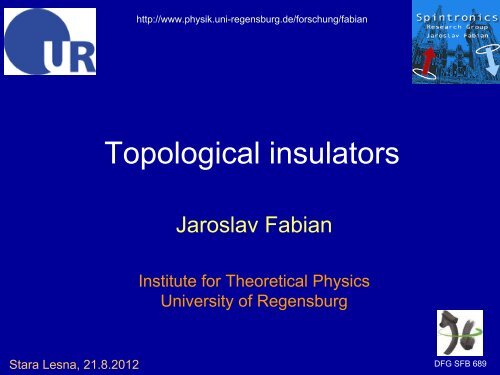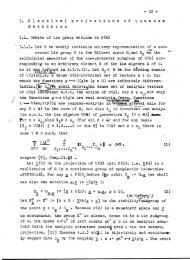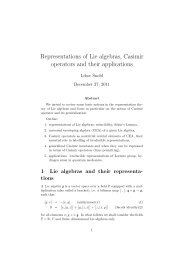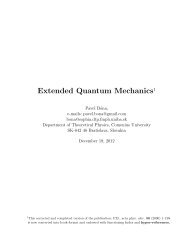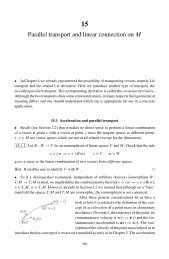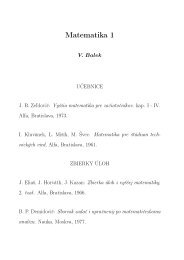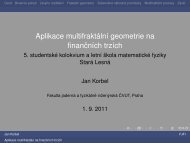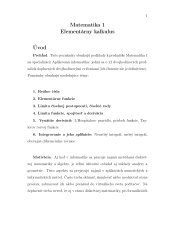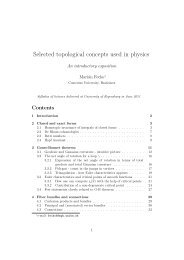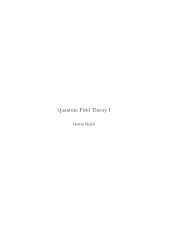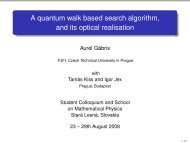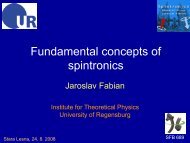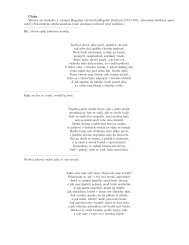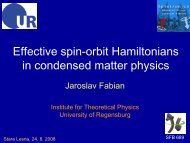Topological insulators
Topological insulators
Topological insulators
You also want an ePaper? Increase the reach of your titles
YUMPU automatically turns print PDFs into web optimized ePapers that Google loves.
http://www.physik.uni-regensburg.de/forschung/fabian<br />
<strong>Topological</strong> <strong>insulators</strong><br />
Jaroslav Fabian<br />
Institute for Theoretical Physics<br />
University of Regensburg<br />
Stara Lesna, 21.8.2012 DFG SFB 689
what are topological <strong>insulators</strong>?<br />
gapped bulk states +<br />
conducting (gapless) edge (surface) states due to topology<br />
M. Z. Hasan and C. L. Kane, <strong>Topological</strong> <strong>insulators</strong>, Rev. Mod. Phys. 82, 3045 (2010)
:outline:<br />
• mesoscopics for pedestrians<br />
• topological <strong>insulators</strong><br />
• edge states in HgTe quantum wells<br />
• magnetism of HgTe edge states<br />
B. Scharf, A. Matos-Abiague, and J. Fabian,<br />
Phys. Rev. B 86, 075418 (2012)
mesoscopics for pedestrians<br />
bulk states<br />
quantum point contacts<br />
current states
How much current per spin flows in a quantum channel?<br />
…….. conductance quantum<br />
…….. resistance quantum
conductance quantization: n-channel transport<br />
…….. conductance quantization
conductance quantization<br />
B. J. van Wees, Phys. Rev. Lett. 60, 848 (1988).<br />
D. A. Wharam et al. J. Phys. C 21, L209 (1988).<br />
e<br />
n=1 (2 spins)<br />
GaAs/AlGaAs QPC<br />
lead resistance subtracted<br />
B. J. van Wees, Phys. Rev. Lett. 60, 848 (1988)<br />
picture from C. W. J. Beenakker and H. van Houten, Solid State Physics, 44, 1 (1991).
integer quantum Hall effect: topological edge states<br />
bulk states<br />
bulk Landau levels<br />
edge states<br />
edge states<br />
no backscattering
integer quantum Hall effect: topological edge states<br />
voltage probe
integer quantum Hall effect<br />
K. von Klitzing, G. Dorda, M. Pepper, Phys. Rev. Lett. 45, 494 (1980)<br />
Si MOSFET<br />
Original MOSFET<br />
von Klitzing’s web site<br />
SdH IQHE<br />
GaAs/AlGaAs<br />
Cl<br />
picture from http://www.ptb.de/en/org/2/Inhalte/qhe/E-quantenhalleffekt.htm
topological nature of the integer<br />
quantum Hall effect<br />
1 st Chern number<br />
Blount-Berry curvature<br />
Blount-Berry phase<br />
Bloch state<br />
D. J. Thouless, M. Kohmoto, M. P. Nightingale, and M. den Nijs, Phys. Rev. Lett. 49, 405 (1982)<br />
Q. Niu, D.J. Thouless, and Y.-S. Wu, Phys. Rev. B 31, 3372 (1985)
topological <strong>insulators</strong><br />
another look at the quantum Hall edge states<br />
quantum Hall edge states come in spin pairs:<br />
time reversal symmetry is broken<br />
skipping orbits<br />
bulk orbits (Landau levels)
topological <strong>insulators</strong><br />
edge states with time reversal preserved: spin-orbit coupling<br />
spin-orbit edge states come in spin pairs, but move opposite:<br />
time reversal symmetry is preserved<br />
edge states<br />
no backscattering !!!<br />
the edge states are topologically protected against TR scattering
emergence of spin-orbit fields<br />
space-inversion symmetry breaking
Time reversal points<br />
spin degeneracy preserved
Z 2 invariance<br />
stable to continuous change of band parameters<br />
even number of crossings<br />
odd number of crossings
(non-exotic) materials classes of<br />
topological <strong>insulators</strong><br />
• Graphene<br />
Kane and Mele, 2005, spin quantum Hall effect<br />
• 2d topological <strong>insulators</strong><br />
Zhang and co., 2006, HgTe quantum wells (see later)<br />
• 3d topological <strong>insulators</strong> (Zhang and Co)<br />
BiSe, BiTe, BiSb …<br />
yet to be experimentally confirmed<br />
first 3d experimental TI<br />
• other special materials structures …
Electronic structure of CdTe and HgTe<br />
CdTe<br />
HgTe<br />
normal band ordering<br />
1.6 eV gap<br />
narrow-gap semiconductor<br />
inverted band structure<br />
“negative band gap” -0.3 eV
HgTe/CdTe quantum wells<br />
CdTe<br />
CdTe<br />
CdTe<br />
CdTe<br />
HgTe<br />
HgTe<br />
2d topological insulator
HgTe/CdTe quantum wells: TI states<br />
B. A. Bernevig, T. L. Hughes, and S.-C. Zhang, Science 314, 1757 (2006).<br />
CdTe<br />
HgTe<br />
2d topological insulator<br />
“trivial” interface states<br />
CdTe<br />
B. A. Volkov and O. A. Pankratov, JETL Lett. 42, 178 (1985)<br />
M. I. Dyakonov and A. V. Khaetskii, JETP Lett. 33, 110 (1981).
experimental evidence of TI states<br />
mesoscopic transport<br />
tunable gate and width<br />
Konig et al. (Molenkapm group, Wurzburg), Science 318, 766 (2007)
experimental evidence of TI states<br />
mesoscopic transport<br />
(d)<br />
R14,23 (Ω)<br />
G = .3 e 2 /h<br />
G = 2 e 2 /h<br />
V g -V thr (V)<br />
Konig et al. (Molenkapm group, Wurzburg), Science 318, 766 (2007)
magnetism of the TI edge states in HgTe<br />
how the edge states evolve with B-field?<br />
CdTe<br />
CdTe<br />
HgTe<br />
B. A. Bernevig, T. L. Hughes, and S.-C. Zhang, Science 314, 1757 (2006).
magnetism of the TI edge states in HgTe<br />
how the edge states evolve with B-field?<br />
B. A. Bernevig, T. L. Hughes, and S.-C. Zhang, Science 314, 1757 (2006).
magnetism of the TI edge states in HgTe<br />
B = 0<br />
B. Scharf, A. Matos-Abiague, and J. Fabian, Phys. Rev. B 86, 075418 (2012)<br />
E [meV]<br />
20<br />
10<br />
0<br />
-10<br />
-20<br />
(a)<br />
Fig. (b) Fig. (c)<br />
2<br />
10.78 1<br />
10.76<br />
10.74<br />
-2 -1 0 1 2<br />
k [10 6 1/m]]<br />
-2 -1 0 1<br />
k [10 6 1/m]<br />
(b)<br />
v k<br />
0<br />
bulk states<br />
v k<br />
0<br />
5<br />
4<br />
3<br />
0<br />
5<br />
0<br />
2 -100 -50 0 50 100<br />
y [nm]<br />
4<br />
3<br />
2<br />
1<br />
ρ [10 13 1/m 2 ]<br />
ρ [10 13 1/m 2 ]<br />
E [meV]<br />
20<br />
10<br />
0<br />
-10<br />
-20<br />
(a)<br />
8<br />
7.6<br />
7.2<br />
Fig. (b)<br />
-2 -1 0 1<br />
k [10 6 1/m]<br />
Fig. (c)<br />
-2 -1 0 1 2<br />
k [10 6 1/m]<br />
(b)<br />
(c)<br />
v k<br />
0<br />
TI states<br />
1.5<br />
1<br />
ρ [10 14 1/m 2 ]<br />
0<br />
1.5<br />
0<br />
2 -100 -50 0 50 100<br />
y [nm]<br />
1<br />
ρ [10 14 1/m 2 ]
magnetism of the TI edge states in HgTe<br />
B =10 T<br />
B. Scharf, A. Matos-Abiague, and J. Fabian, Phys. Rev. B 86, 075418 (2012)<br />
E [meV]<br />
100<br />
50<br />
0<br />
-50<br />
(a)<br />
Fig. (b)<br />
Fig. (c)<br />
(b) v k<br />
0<br />
QH edge states<br />
5<br />
4<br />
3<br />
2<br />
1<br />
0<br />
5<br />
4<br />
3<br />
2<br />
1<br />
ρ [10 14 1/m 2 ]<br />
ρ [10 14 1/m 2 ]<br />
E [meV]<br />
100<br />
50<br />
0<br />
-50<br />
(a)<br />
Fig. (b)<br />
Fig. (c)<br />
(b) v k<br />
0<br />
QH edge states<br />
5<br />
4<br />
3<br />
2<br />
1<br />
0<br />
5<br />
4<br />
3<br />
2<br />
1<br />
ρ [10 14 1/m 2 ]<br />
ρ [10 14 1/m 2 ]<br />
-100<br />
-2 -1 0 1<br />
k [10 9 1/m]<br />
0<br />
2 -100 -50 0 50 100<br />
y [nm]<br />
-100<br />
-2 -1 0 1<br />
k [10 9 1/m]<br />
0<br />
2 -100 -50 0 50 100<br />
y [nm]
magnetism of the TI edge states in HgTe<br />
how the edge states evolve with B-field?<br />
B. Scharf, A. Matos-Abiague, and J. Fabian, Phys. Rev. B 86, 075418 (2012)<br />
100<br />
E [meV]<br />
50<br />
0<br />
-50<br />
SQH<br />
QH<br />
-100<br />
0 2 4 6 8 10<br />
B [T]
magnetism of the TI edge states in HgTe<br />
bulk magnetic susceptibility<br />
B. Scharf, A. Matos-Abiague, and J. Fabian, Phys. Rev. B 86, 075418 (2012)<br />
χ [10 17 J/(Tm) 2 ]<br />
8<br />
6<br />
4<br />
2<br />
0<br />
-2<br />
-4<br />
-6<br />
-8<br />
T = 1 K<br />
T = 10 K<br />
T = 100 K<br />
μ = 20 meV<br />
0.25 5 10 15 20<br />
1/B [1/T]<br />
χ [10 17 J/(Tm) 2 ]<br />
8<br />
6<br />
4<br />
2<br />
0<br />
-2<br />
-4<br />
-6<br />
-8<br />
T = 1 K<br />
T = 10 K<br />
T = 100 K<br />
μ = 20 meV<br />
0.25 5 10 15 20<br />
1/B [1/T]
Conclusion<br />
topological <strong>insulators</strong> are a new playground for<br />
(not only*) solid state physicists<br />
*X. Qi, E. Witten, and S. Zhang, Axion topological field theory of topological <strong>insulators</strong>, arXiv: 1206.1407


